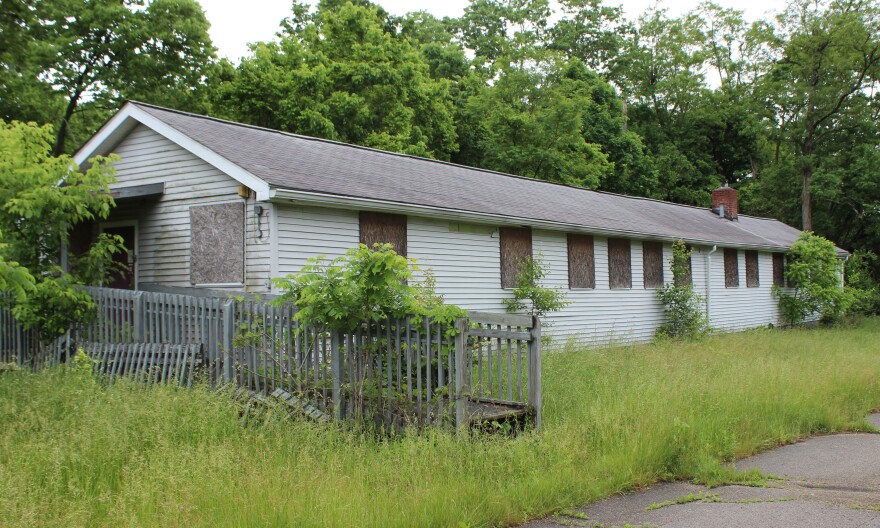Our feature OKI Wanna Know is a chance for you to ask a question that could open up a whole new world for you. Or at the very least scratch that intellectual itch that's annoyed you for years. This week we have a pair of questions about Cincinnati Parks.
Monika Nunez asks: Why are there bricks inside multiple trees at Alms Park?
Dave Boutelle oversees the operations of 57 park properties for the Cincinnati Park Board. One of those is Alms Park. The 94-acre site boasts a commanding view of Lunken Airport, and the Ohio River.
"It is beautiful, (and) has a nice variety of trees, and some of the older ones are pretty majestic."
Alms Park's pavilion is a popular wedding site, and nearby there are two trees with concrete blocks in them. The bald cypress trees are about 100 years old. In that time, the trees have grown around the blocks, making it look like there's a wall separating this world from Narnia, or another dimension.
"Decades ago, it was common practice for people to fill cavities of tree trunks with this material thinking it was good for the tree and would help the tree last longer," Boutelle says.
He adds there's not a lot of scientific evidence to back up the theory. He says in practice, it makes the tree weaker.

"Moisture stays in there, causes more fungus or rot. Also insects can still easily get in there and do their thing, whether it's carpenter ants, termites or other bugs."
Boutelle says the bricks also make the tree more rigid, and less able to sway in the wind.
Near the two bricked-up trees, there's an old weeping cherry tree, with a lot of unfilled cavities. "Some species of trees are better than others at compartmentalizing decay," he says. "And some species are better than others at being able to still be strong even if it has hollow cavities in its trunk or limbs."
Boutelle estimates the bricks were inserted into the trees in the 1950s or '60s. He says there are apparently some trees in Mt. Airy Forest with bricks, too, but he's not sure if other parks have them.
Now about that parking lot in the forest...
And our next question happens to be about Mt. Airy Forest. Natalie Reno says on the west side of the park, at the end of Diehl Road, there are paved roads that lead into the forest. There's at least one building, and Google Earth satellite photos show more roads and parking lots. She wants to know what it all used to be.
If you go to the end of Diehl, the road splits. To the right, the road is blocked, and a sign reads "city employees only." Talbert House used to have a facility to the left. The center closed and was demolished by 2016. There is another building further east in the forest. Cincinnati Parks says it was part of the barracks for the Civilian Conservation Corps.

Gray Brechin, project scholar with the Living New Deal, says the entire site was once a CCC work camp, one of many across the country. The CCC sprang out of President Franklin Roosevelt's New Deal, designed to put people to work and get the country out of the Great Depression.
"It was an army of about three-and-a-half million young men who were recruited to conserve America's land. They planted over three-and-a-half million trees, so some of those were planted in Mt. Airy," Brechin says.
The Living New Deal website reports on July 10, 1935, the first crew started work on Mt. Airy. Brechin says the building that's still on the site may have been barracks, a mess hall, an infirmary or a recreation hall.
"Those buildings are quite rare, because they weren't built very well. They had to be put up very quickly. But it looks like you've got one of the rare CCC buildings still intact in Mt. Airy park," he says.
Brechin says the Mt. Airy camp was home to a crew of about 20 Black men. They not only planted trees, but built roads, picnic shelters and public bathrooms. Brechin says there is an effort underway nationwide to recognize CCC workers with statues at the sites where they worked.
"They're very handsome statues. Unfortunately they all have Caucasian features. I think it would be wonderful if one would be put into Mt. Airy park with African American features so people would see what Blacks did, how they contributed to the parks we enjoy today."
Today, Mt. Airy Forest is Cincinnati's largest park, covering 1,459 acres. It's on the National Register of Historic Sites.
If you have a question and don't know where to get an answer, try asking OKI Wanna Know by filling out the form below. We may answer it in a future episode!




